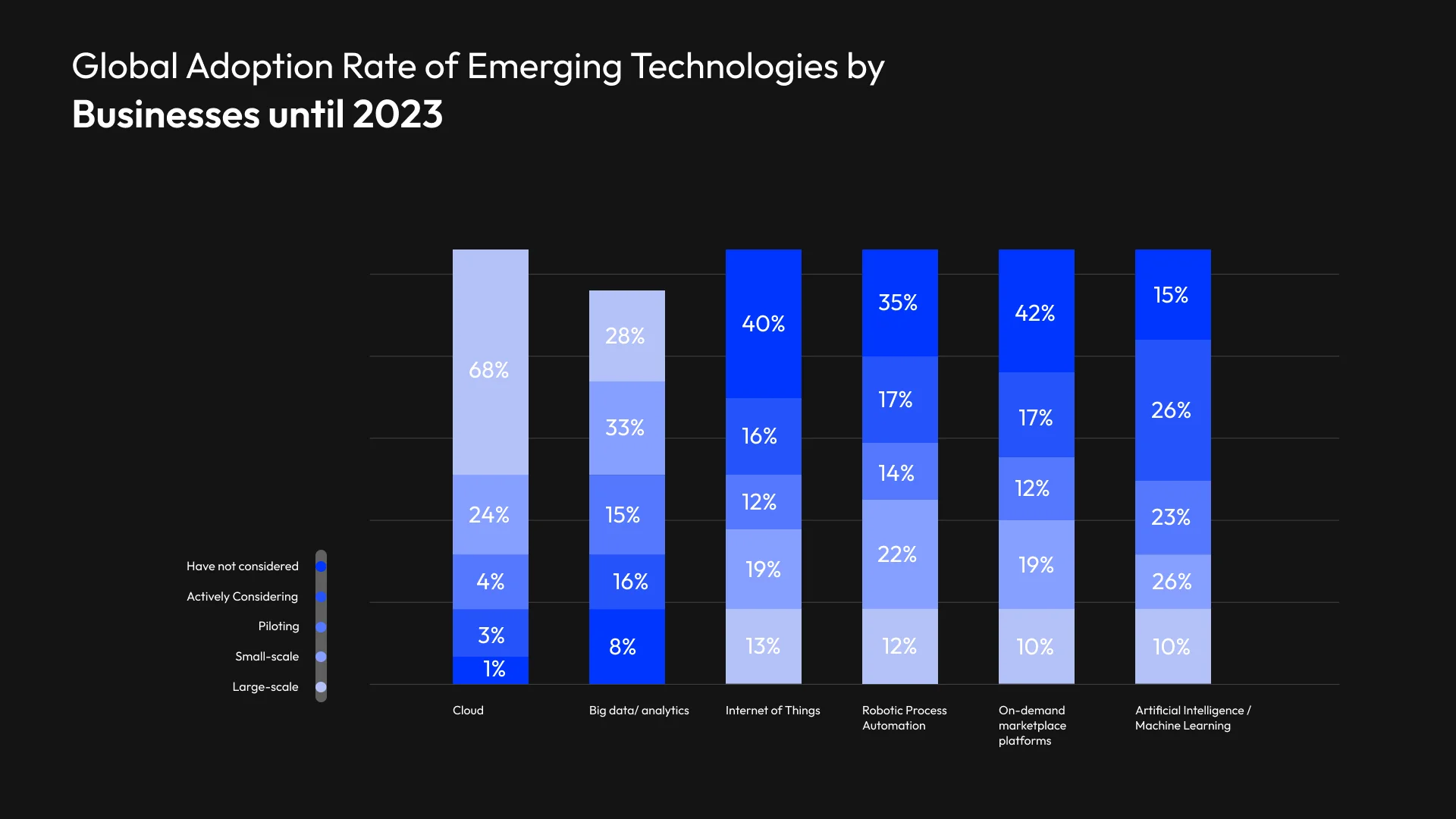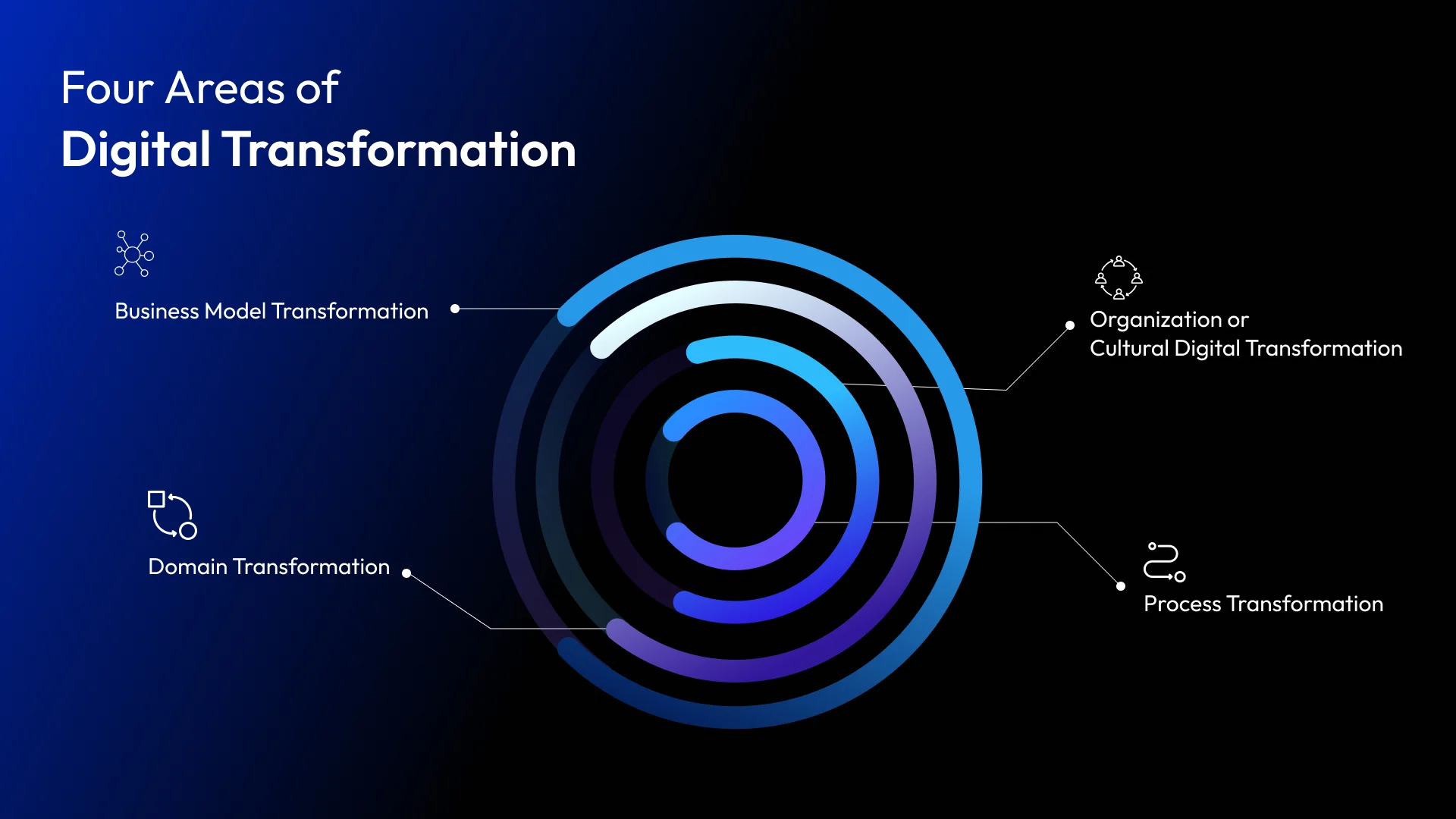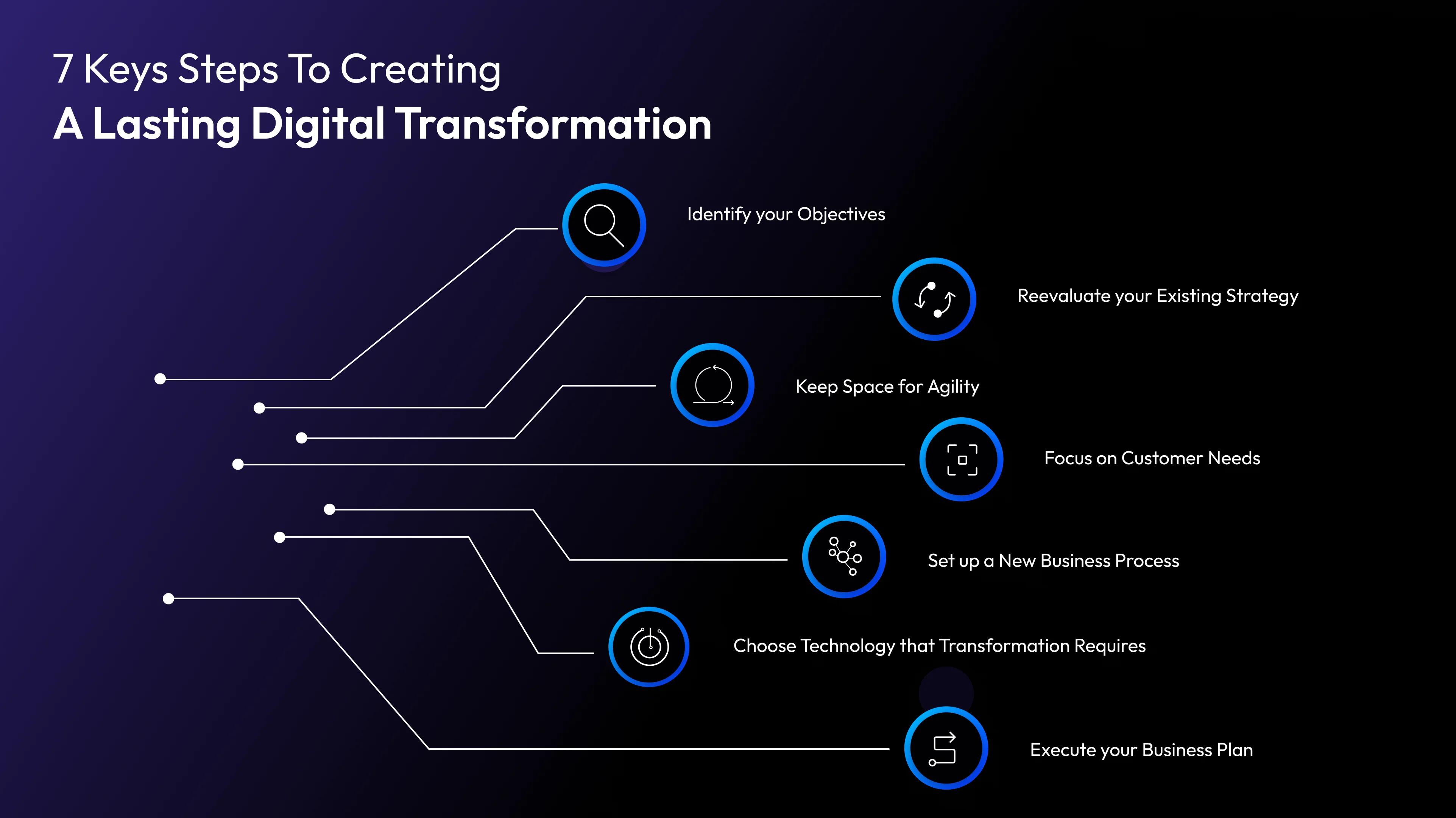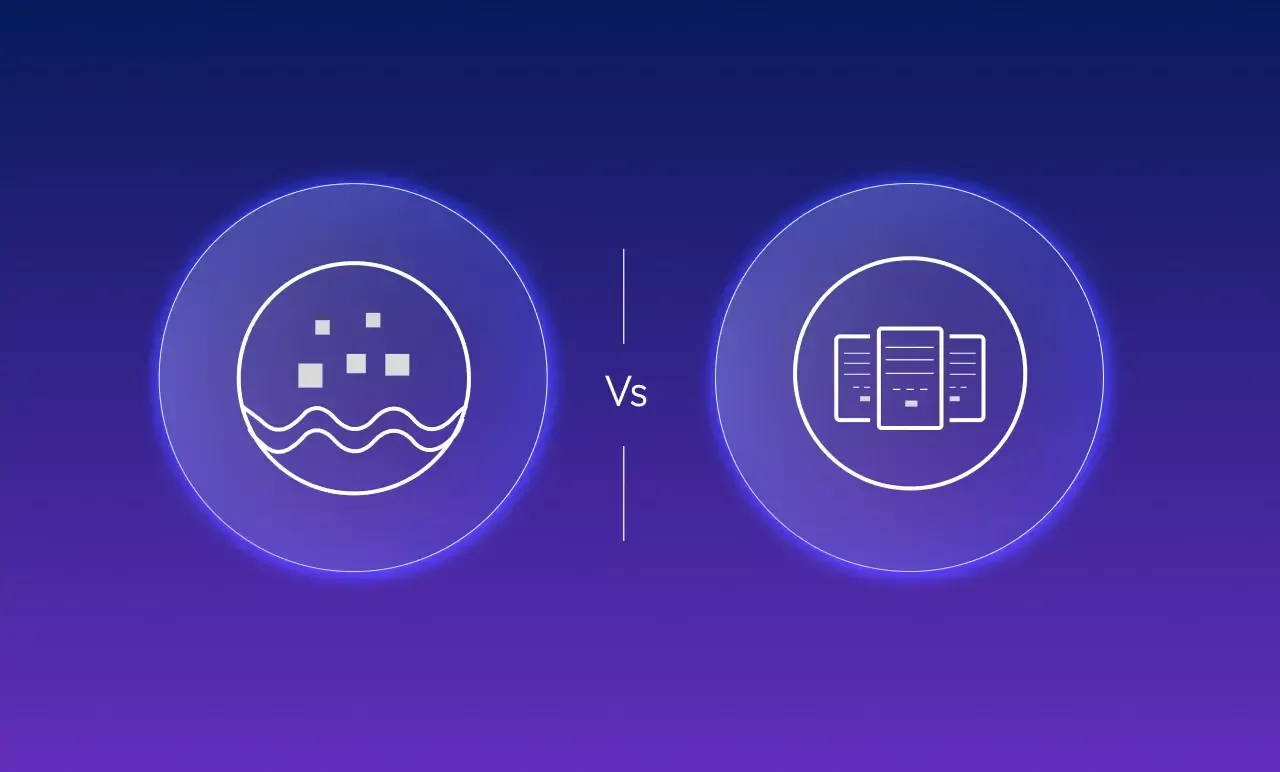Data Storage Decoded: Data Warehouse vs Data Lake Explained
How To Create a Digital Transformation That Lasts
Technological advancements and economic trends drive the business world's dynamic and constant evolution. To stay viable in this fast-paced business environment, the need for digital transformation has become more relevant than ever. The rise of new-age technologies like Artificial Intelligence, Web3, and Metaverse has made the message loud and clear.
The rapidly changing digital landscape has made digital transformation one of the top corporate agendas for the past few years, with no signs of slowing down. The Google Trends search volume also indicates that businesses should focus more on digital change to gain a distinctive edge in this cut-throat competition.
Deploying next-gen technologies at scale continuously helps them create value and respond better to market changes. While digital transformation seems exciting, most businesses feel overwhelmed and need help figuring out where to start. This article is a comprehensive guide to starting your transformation journey through a planned and holistic approach while identifying the key challenges. Furthermore, considering the budget and time constraints, it is ideal to outsource it to an experienced digital transformation company to make the transition efficient and smoother.
What exactly is the Digital Transformation Process?
Digital transformation implies companies utilizing modern and cutting-edge technologies to modify business processes or create new processes to drive fundamental changes. The benefits? Improved customer experiences, enhanced business efficiency, reduced costs, and better business agility.
Digital transformation refers to adopting new-age technologies and redefining business processes to stay competitive and relevant. For most business entities, digitization necessitates a shift from conventional thinking to a more collaborative and experimental business approach.
Why is Digital Transformation necessary?
Digital transformation drives positive changes in the organization's operating model, workflows, and cultures. Accelerated digital change by embedding advanced technologies helps a business outpace its peers and stay ahead of the curve. So, tech investments such as Artificial Intelligence, data analytics, machine learning, and cloud computing are the need of the hour.
To simplify further, we list the five most prominent reasons for your organization's digital transformation strategy.
Automating workflows
Artificial Intelligence and Machine Learning can help automate repetitive manual tasks and accelerate the work process. AI is an automation technology that trains machines to imitate human-like intelligence. AI-powered tools continuously learn and update themselves to act and produce responses like humans.
Improved efficiency and productivity
Leading-edge technologies like AI, ML, and cloud migration streamline business operations and reduce inefficiencies, boosting productivity.
Encourages competitiveness
Embracing new technologies helps an organization adapt to rapid market changes and lead the market with novel offerings.
Data-driven insights
Data analytics tools can help businesses predict and identify market trends and make informed decisions. You can move beyond instincts and guesswork and make business-critical decisions based on concrete insights and data on past customer behaviors and trends.
Enhanced customer experience
By introducing technical innovation, you can personalize customer experience, offer tailored solutions, and elevate customer satisfaction. If you are still deciding whether technology adoption should be on your priority list now, here is Statista's latest report to clarify your thoughts. As of 2023, more than 92% of the global digital transformation leaders, both small and large, have adopted cloud technologies. The second most popular adopted technology is Big Data analytics, followed by the Internet of Things (IoT) and Robotic Process Automation (RPA).

Source: Statista
Digital Learning Curve - The Three Phases of Transformation
Before beginning the transformation journey, every business must walk through the digital learning curve comprising three distinct phases - modernization, enterprise-wide transformation, and new business creation, to ensure a successful transformation. Let's get into their details one by one.
Step 1: Modernization
As the name implies, modernization implies digitizing existing business processes or workflows to make them more efficient and user-friendly. One example is creating a mobile application for your customers or introducing new touchpoints for self-service to drive conversions faster. Furthermore, automating HR processes through an easy-to-use employee portal modernizes the employee experience and simplifies HR operations.
Step 2 - Enterprise-wide Transformation
This stage primarily involves a company's fundamental shifts in the value propositions, mainly how it operates and competes. Enterprise-wide digital transformational efforts aim to improve existing processes and introduce new processes while aligning with traditional silos.
Real-world examples are Adobe and Microsoft, which offer digital subscriptions to their software applications instead of CD-ROMs.
Step 3 - New Business Creation
Step three is about expanding or scaling your business and opening new revenue streams. It could involve integrating big data analytics to forecast market trends and patterns to optimize business performance or shifting to a new business model using new tech-driven strategies.
Transitioning from traditional operations to new ones is challenging, but with the right kind of leadership, a business can rethink its boundaries and push itself to new limits.
Four Areas of Digital Transformation
A successful digital transformation opens doors to significant growth and expansion while enhancing customer experience that was previously thought impossible, especially for small and mid-sized businesses. However, with proper planning, digital transformation strategy, and execution, this type of transformation is easy to achieve.
There are four key areas that you need to consider to give your business a digital change.
Process Transformation
Process transformation is a thorough assessment of your existing business processes or systems to identify the prime areas for improvement and find better ways to address the challenges. This transformation aims to boost the company's efficiency and streamline operations by integrating emerging technologies.
Planning new result-oriented strategies, establishing baseline metrics, and mapping out the best-case scenario are three fundamental steps in process transformation. Following this roadmap can bring drastic changes and modernize your business processes quickly.
Business Model Transformation
Technology-enabled business models create new customers' value propositions and generate new market opportunities. Simply put, a business transformation redefines how an organization operates and delivers customer value. The process involves adapting to market changes, encouraging competitiveness, and enhancing performance. Take the case of leading brands with platform-based business models like Amazon and Uber. They are leveraging digital technologies to connect buyers and sellers or service providers and create new marketplaces for higher revenue generation.
Domain Transformation
Domain transformation works when there is any area in your business that receives less attention yet holds enormous potential to create new business value. Implementing new technologies and redefining those areas of services or products results in a domain transformation, opening up new growth opportunities. The best example here is the launch of Amazon Web Services (AWS) by top online retailer Amazon, using which it entered a whole new market domain. AWS's reliable and cost-effective cloud services have made it the world's largest cloud infrastructure service provider in today's time.
Organization or Cultural Digital Transformation
A successful digital transformation is more than just implementing new technologies, modernizing work processes, and redesigning products. It includes acceptance by the organization's culture to align perfectly with its internal values and cultures. Negative repercussions might result in slow technology adoption and loss of productivity and, thus, revenue. So, what do you need to do? While venturing into your digital transformation journey, you make a collaborative and comprehensive effort to smoothly shift your organization's culture to comprehend, advance, and adopt technology transformation.

7 Keys Steps To Creating A Lasting Digital Transformation
Digital transformation is not a cakewalk! It is a challenging process that requires time to show results. However, with the correct attitude, planning, and implementation, technological change can be brought about and evolved along with the process.
So, here's a rundown of the steps to creating an ideal transformation plan.
Identify your Objectives
As we already discussed, digital transformation can affect four areas of an organization. So, first, pinpoint the exact areas that need special attention and set specific goals for business transformation. Identifying your transformation objectives will help you develop an efficient plan of action. Any business plan works on two pillars: a mission to define its purpose and a vision to steer the path it serves. When the answers to these questions are clear, you are all set to go!
Reevaluate your Existing Strategy
You already have a business strategy that states your core functions, goals, and mission for the next few years. But is it still relevant, given the fast-paced evolution of the digital landscape? You need to reevaluate your existing strategy and see whether it is still right in place.
Carefully review your existing model, challenge it, and make way for innovative and advanced transformation to boost productivity and efficiency.
Focus on Customer Needs
The ultimate goal behind digital change is to enhance customer experience. To do this, you need to rethink your customer value proposition, figure out how to add more value to your customers and reach a broader market. Considering customer requirements first plays a critical role in driving the business transformation's success. Digital interactions through effective user management and communication channels improve customer experience with products or services. For instance, IoT sensors for washing machines allow users to remotely adjust water temperature and be notified when a cycle finishes.
Set up a New Business Process
Pursuing digital transformation efforts is difficult with the old or existing business strategy. Hence, plan and develop a new business model that aligns with your transformation needs.
To achieve long-term success, your business process must be in sync with your digital business transformation goals.
Choose Technology that Transformation Requires
Digital transformation is only possible with digital technology adoption. So, the next thing you need to do is identify what technologies you need to integrate into your business process to achieve your goals. It could be anything, from cloud computing to artificial intelligence and data analytics to blockchain. Whether you want to streamline operations or stir up business workflows by gauging time and cost, choose the technologies that fit perfectly with the requirements and meet the organization's standards.
Execute your Business Plan
This is the phase when you are ready to put your intent plan into action after completing all the preparatory steps. Also, once you have all the technology infrastructure you need, you can jumpstart your transformation process. Remember, it is not a one-day task. It comprises several stages, each of which may take weeks or even months. Most importantly, follow a collaborative approach in which every team member comes together to evaluate progress, analyze problems, and find ways to address them.
Keep Space for Agility
Sustaining your transformation model for the future is essential to continue reaping its benefits later. Strategic planning and adaptation to changing business environments are necessary to ensure high performance and successful results in the upcoming years. During the transformation, your business can face challenges that might give a setback or get opportunities that will drive its success. In both scenarios, you need to learn from the lessons that you can use later to create foolproof business strategies for the future.

The Bottom Line
The path of transformation is not a race you must finish in a single stretch. It is an incremental process involving several stages, and it is natural for businesses to face obstacles or challenges for the first time. However, this should not refrain from embracing the idea of transformation and continuing with the age-old process.
Digital transformation takes time, but the results are certainly worth waiting for. If you focus on the right digital transformation technologies, have the best team, and have a perfect long-term vision, results will follow automatically. Once you master the skill of digital transformation strategy and identify the channels through which you need to put them into practice, there is no looking back.
Looking to embark on a digital transformation journey?
Our expertise in digital transformation ensures a seamless transition, enhances end-user experience, and keeps pace with the ever-changing market landscape. We have successfully transformed esteemed digital brands like Liberty Homeguard, P.C Chandra Jewellers, and Grid. Backed by over 17 years of hands-on experience and twenty prestigious global awards, Sundew is your go-to partner for all your tech aspirations.
Email us or Talk to us at +91-98367-81929 or Simply Contact Us through the website.
Let's Connect












